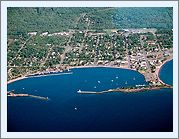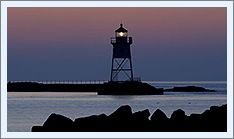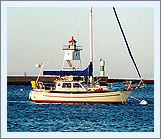 |
 |
 |
|
Click thumbnails to view enlarged versions |
||
| Grand Marais Light | Seeing The Light |
|
|
|
|
Historical Information Richard Godfrey was the areas first white settler, arriving in the bay in 1854 to establish an independent fur trading post. Soon after his arrival, Godfrey arranged to have himself appointed as the areas first postmaster, and convinced that the bay held considerable commercial potential, began lobbying the Federal Government to undertake harbor improvements. On May 26, 1856, Minnesota Territorial Representative Edmund Rice took up Godfrey's cause in the House of Representatives, presenting a memorial on behalf of citizens of Minnesota Territory, praying "for the erection of light-houses at Beaver Bay and Grand Marais." Unaware of the issues at such a distant point on the frontier, the matter was forwarded to the House Committee on Commerce for evaluation and recommendations. Evidently, the Commerce Committee returned with a favorable recommendation, as Congress appropriated the sun of $6,000 for the construction of a Light at Grand Marais on August 18 of that same year. While the Lighthouse Board reported that an examination of the site was to be undertaken in its annual report for 1856, history indicates that even though the funds were made available, no further steps were taken towards establishing either the light at Beaver Bay or Grand Marais. Richard Godfrey abandoned his interests at Grand Marais in 1857 and returned to Detroit, and it appeared in all respects that neither the town of Grand Marais, nor its lighthouse were destined to become a reality.
In order to reduce costs, Davis decided to make extensive use of surplus components. On the grounds of the Detroit depot, a surplus octagonal cast lantern was incorporated into a timber-framed enclosed pyramid timber tower of approximately 32 feet in height. The 1,500 pound fog bell and automatic striking apparatus removed from the Passage Island Light in 1884 was installed in the structure with the bell suspended from a bracket on the exterior of the structure, and the automatic striking apparatus within an enclosed room below the lantern. On completion, the structure was disassembled, loaded onto the lighthouse tender WARRINGTON, and transported to Grand Marais, where it was erected at the end of the east pier. A fixed white Fifth Order Fresnel lens manufactured by Sautter & Cie., of Paris was carefully assembled in the lantern, and the automated fog bell apparatus adjusted to emit the predetermined characteristic of a double blow every 30 seconds. While construction was completed in 1885, it appears that the light was not exhibited until after February 23, 1886, when Acting Keeper Joseph E Mayhew first appears listed at the station in official District records. With an official survey of the growing village of Grand Marais imminent, the decision to delay construction of the keepers dwelling until the completion of the survey was made, in order to identify the most appropriate location.
The base of the tower was again damaged in 1890, and a work crew dispatched to renew the timber protection. While at the site, the crew also erected a 42-foot long set of boat ways and boat house outfitted with a pair of davits for the safe storage of the keeper's boat. However, negotiations on the reservation for the keeper's dwelling were still frustratingly unresolved, and Mayhew continued to serve without an official dwelling. With the portion of the original appropriation allocated for the dwelling unexpended, the funds were recalled by the Treasury Department. With the appropriation no longer available, negotiations for the property were discontinued. A new appropriation for the construction was not made until March 2, 1895, when $4,000 was appropriated for the purpose. Eleventh District Inspector Commander William W. Mead tendered an offer for an alternate site for the dwelling, and on acceptance by the owners, the process of obtaining clear title was well underway by the end of the year.
With the turn of the century, Grand Marais experienced a population surge as homesteaders moved into the area. Under the homestead act, an individual could obtain title to up to 160 acres of unimproved land at no cost, provided that a minimum of five acres were cleared and a permanent dwelling raised within the first five years. Once title was obtained, homesteaders could then sell the lumber and mineral rights to the property, making a good profit on part of their holdings. Without a large dock in town, there was not a great deal of vessel traffic in the harbor beyond those seeking refuge, and the supply boats from Duluth were forced to anchor in the deeper water out in the harbor while supplies were lightered to and from shore.
The following year, the decision was made to convert the west breakwater light to Pintsch gas illuminant, and contracts were awarded out of the Detroit office for a new tower and gas apparatus. Plans for the tower called for a square steel pyramid skeleton equipped with a platform and railing. The contractor delivered the tower components to the Detroit depot on June 15, 1903, and it was delivered to the breakwater in Grand Marais late that year. However, with the onset of winter, the installation was suspended and brought to completion the following spring.
John Woods resigned his position as Keeper on April 1, 1921, and the indomitable Emmanuel Luick was transferred in from the Sand Island Light in the Apostles. On July 19 of the following year, the characteristic of the main Pier Light was modified to an isophase characteristic consisting of 5 seconds of light followed by a 5-second eclipse.
While the west breakwater light was
replaced by an ignominious D-9 cylinder in the 1960's, the 1923 east
pier light still serves to guide pleasure boats into the harbor. The old
keeper's dwelling is now owned by the Cook County Historical Society,
which operates the building as a museum. The museum is open to the
public during the summer months from 10.00 AM to 5.00 PM, and 12.00 PM
to 5.00 PM on Sundays. |